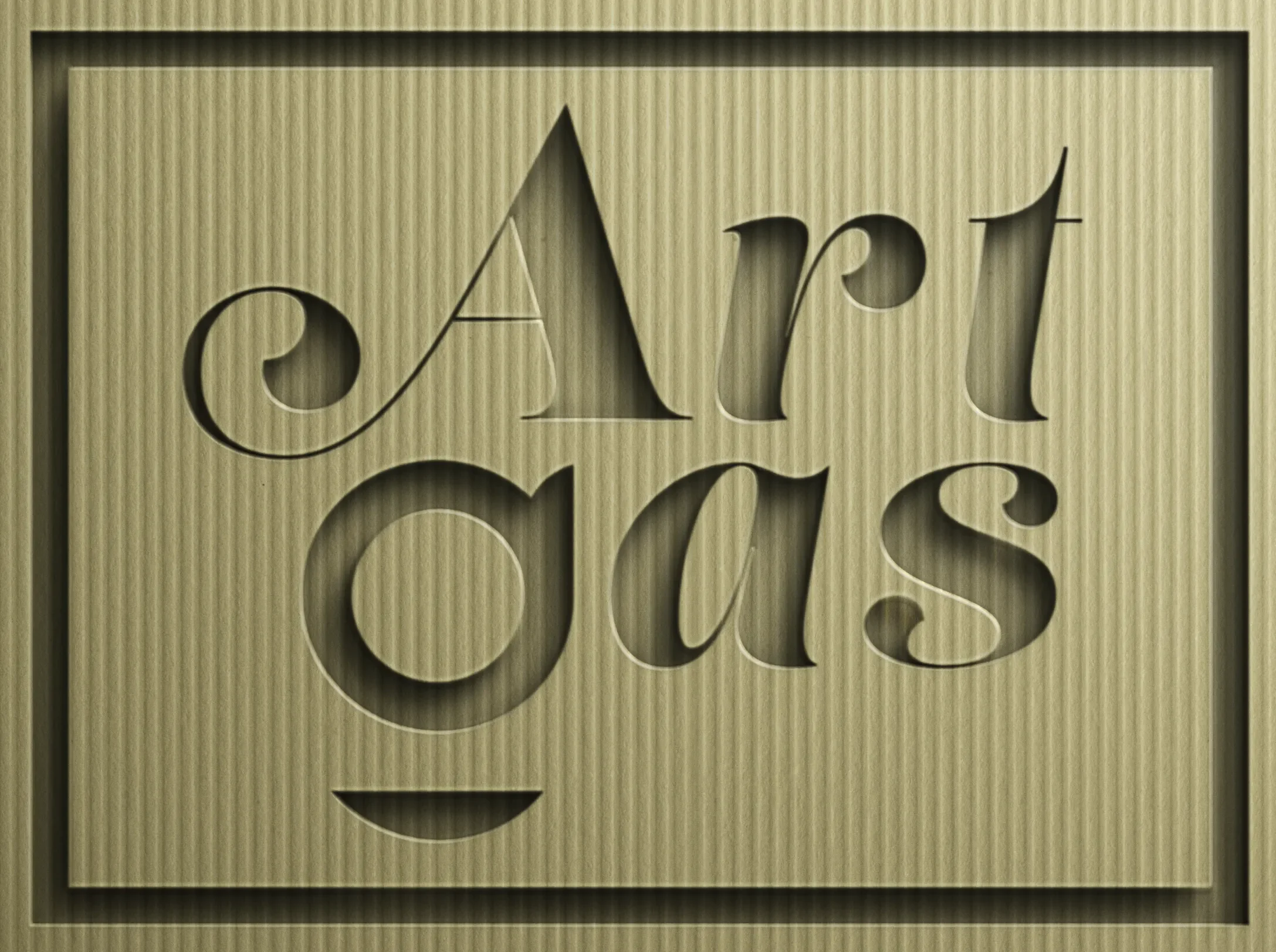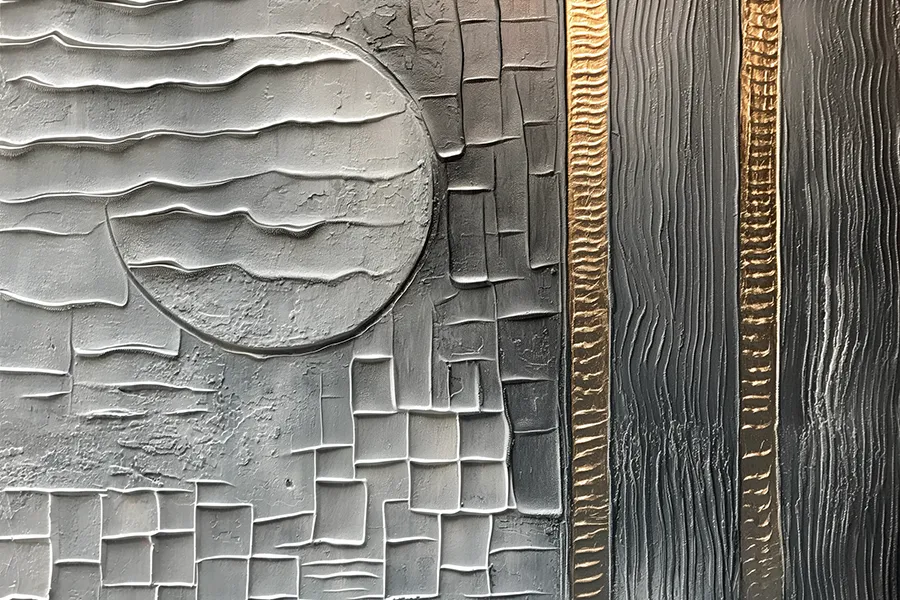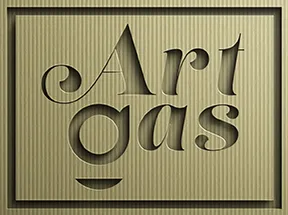A Guide to Techniques, Trends, and the Allure of Textured Modeling Paste Abstract Art
Modeling paste is a versatile artistic medium that invites artists to create stunning textural depth and intricate surface detail in their abstract artworks. When combined with bold colors and expressive compositions, modeling paste takes abstract art to a whole new dimension. In this ARTicle, we’ll explore the history, techniques, and variations of modeling paste abstract art, and examine how digital tools and AI are revolutionizing this compelling art form.
Overview and History
- Roots in Mixed Media: Modeling paste, a thick, malleable compound, has long been used in mixed-media artwork to add texture.
- Abstract Expressionism’s Influence: During the mid-20th century, Abstract Expressionist artists like Willem de Kooning and Jackson Pollock incorporated heavy impasto (thick paint application) techniques, paving the way for greater textural experimentation.
- The Rise of Modeling Paste Abstract Art: In recent decades, modeling paste has become a central focus in abstract art, with artists embracing its ability to create dramatic peaks, valleys, cracks, and patterns on canvas.
Why is Modeling Paste Abstract Art Popular?
- Tactile Allure: Modeling paste adds a sculptural quality to abstract works, inviting viewers to engage with the artwork not just visually, but through a sense of touch.
- Expressive Potential: Thick textures, cracks, and dramatic impasto-style application introduce a sense of dynamic energy and emotionality to abstract compositions.
- Visual Complexity: The interplay of light and shadow on a textured surface creates captivating visual complexity that invites exploration and contemplation.
Who Does Modeling Paste Abstract Art Appeal To?
- Art Lovers Seeking Depth: Those who appreciate artworks that go beyond flat surfaces and embrace three-dimensionality.
- Collectors Drawn to Unique Textures: Individuals seeking distinctive artworks that stand out with their tactile qualities.
- Interior Design Enthusiasts: Modeling paste abstract art offers statement pieces for contemporary spaces, adding both visual interest and a sense of artistic sophistication.
Top 10 Classic Variations of Modeling Paste Abstract Art
- Impasto Landscapes: Thick applications of modeling paste create textured interpretations of mountains, deserts, or seascapes, with a focus on tactile rather than representational accuracy.
- Sculptural Gestural Abstraction: Large, sweeping gestures applied with modeling paste, emphasizing the physical act of creation and conveying raw emotion.
- Minimalist and Textured: Simple geometric shapes composed with modeling paste, creating a dialogue between form, texture, and subtle color variations.
- Pattern and Repetition: Intricate patterns etched into modeling paste, creating mesmerizing repeating motifs that draw the viewer’s eye.
- Layered and Mixed Media: Modeling paste combined with paint, textiles, or found objects, expanding the expressive potential of textured abstracts.
- Crackled Surfaces: Adding substances to modeling paste that create deliberate cracks when dry, producing unique artistic effects.
- Monochromatic Textured Abstracts: Focusing entirely on variations within a single color, highlighting the interplay between texture, light, and shadow.
- Nature-Inspired Textures: Abstractly depicting the textures found in nature, like tree bark, sand, or rock formations, using modeling paste as the primary medium.
- Metallic Textured Abstracts: Incorporating metallic pigments or leaf into the modeling paste, adding a luminous and luxurious dimension.
- Textured Figuration: Blending figurative elements with heavy modeling paste application, creating distorted or partially obscured faces or forms.
Top 10 Digital/AI Variations of Modeling Paste Abstract Art
- Digital Sculpting for 3D Printing: Creating abstract forms with textured modeling paste effects in a virtual environment, then 3D printing them for physical artworks.
- AI-Generated Textural Patterns: Using algorithms to generate unique patterns that mimic the crackled, layered, or etched effects achievable with modeling paste.
- Texturized Image Manipulation: Applying AI-powered textured filters to digital photographs or paintings, transforming them into abstract artworks with a modeling-paste aesthetic.
- 3D Textured Mapping for Animation: Adding dynamic textures to animated abstract forms, simulating the way light interacts with modeling paste.
- Virtual Impasto Painting Tools: Digital art software with brushes that mimic the thick, expressive application of modeling paste. … (Let’s continue with the remaining 5 styles)
- Hybrid Digital-Physical Abstracts: Scanning a textured physical artwork made with modeling paste, then manipulating it digitally for unique hybrid creations.
- AR Textured Projections: Projecting digital simulations of modeling paste textures onto real-world surfaces, creating temporary interactive art installations.
- Textural Soundscapes: Translating the textures of modeling paste abstract art into sound-based compositions, where peaks and valleys become audible frequencies.
- AI-Assisted Texture Design: Using AI tools to analyze existing modeling paste artworks and suggest new textures or patterns for artists to explore.
- Virtual Gallery of Textured Artworks: A dedicated online gallery featuring 3D renderings of textured abstract artworks, allowing viewers to zoom in and explore details up close.
Absolutely, let’s continue with FAQs about modeling paste abstract art and introduce some noteworthy artists in this realm.
FAQs About Modeling Paste Abstract Art
- What is modeling paste made from? Modeling paste typically consists of a filler, like marble dust, and a binder, such as acrylic resin. This forms a thick, white paste that dries to a hard, textured surface.
- How is modeling paste applied in artworks? Artists use a variety of tools to apply modeling paste, including palette knives, brushes, trowels, and even their own hands. It can be spread, layered, etched, or sculpted.
- Does modeling paste require special considerations when painting? Yes, it’s often recommended to apply a primer like gesso to the canvas before using modeling paste to ensure good adhesion. Artists may also choose to paint over the dried modeling paste with acrylics or oils for pops of color.
- Is modeling paste suitable for outdoor artworks? Some brands offer modeling paste specifically designed for outdoor use. However, it’s important to consider factors like weather resistance and potential warping of the support (canvas or board) when choosing modeling paste for outdoor projects.
- How long does modeling paste take to dry? Drying time varies depending on the thickness of the application. Thin layers can dry within hours, while thick applications can take several days or even weeks to fully cure.
- Is modeling paste messy? Yes! It can be a bit messy to work with, but that’s part of the fun. Protect your workspace, wear gloves if desired, and embrace the creative process.
- How do I clean modeling paste off my tools? Clean your tools with water while the paste is still wet. Dried modeling paste can be more challenging to remove, and may require soaking or gentle scraping.
- Where can I buy modeling paste? Most art supply stores carry a variety of modeling paste brands and textures to choose from. Experiment to find your desired consistency and effects.
- Can I mix my own modeling paste? Yes, there are recipes available online for creating your own modeling paste using ingredients like sawdust, plaster, and acrylic medium.
- How do I care for a textured abstract artwork made with modeling paste?
Avoid excessive moisture and direct sunlight. Dust gently with a soft brush to keep it looking its best.
Noteworthy Artists: Modeling Paste Abstract Art
Classic Artists
- Frank Stella ([invalid URL removed]): Influential for his shaped canvases and textured mixed-media works.
- Anselm Kiefer (https://www.whitecube.com/artists/artist/anselm_kiefer): Known for heavily textured works incorporating materials like straw and sand.
- José Parlá (https://www.joseparla.com/): Creates layers of ‘calligraphic’ marks, textured paint, and found elements.
Contemporary Artists
- Ryan Johnson ([invalid URL removed]): Sculpts and carves dramatic textures with modeling paste and paint.
- Kathryn Armstrong ([invalid URL removed]): Creates richly textured, gestural abstractions with a focus on process.
- Angela Fraleigh (https://www.angelafraleigh.com/): Uses modeling paste, marble dust, and pigments to create ethereal layered abstractions.
Let’s get creative with some Midjourney prompts in the next section!
Let’s focus on prompts that capture the essence of modeling paste’s unique qualities:
Classic Styles
- Impasto Landscape: A desert landscape rendered in thick modeling paste, cracked earth, swirling sand dunes, hyperrealistic detail –aspect 3:4
- Sculptural Gestural Abstraction: Bold strokes of modeling paste, volcanic eruptions of color, a sense of raw energy and movement –aspect 4:3
Digital/AI Styles
- Digital Impasto Painting: A close-up of textured brushstrokes digitally painted to mimic the thick, expressive application of modeling paste –aspect 3:4
- Hybrid Digital-Physical Abstract: A scanned and digitally manipulated modeling paste artwork, with glitched textures and fluorescent color overlays –aspect 4:3
Important Note: Midjourney often struggles to accurately replicate real-world textures. These prompts serve as inspiration, and you’ll likely get more interesting results by adding descriptive terms like “luminous,” “cracked,” “layered,” or focusing on abstract shapes and colors. Experiment and have fun!
SEO Keywords (Let’s add some more)
- Impasto abstract art
- Textured abstract art
- AI art texture generation
- Digital art tools for texture
- Hybrid physical-digital art
Would you like to finish with the conclusion and a call to action for your Artgas collection?
Conclusion
Modeling paste abstract art offers a world of textural possibilities. From the expressive landscapes and minimalist compositions of classic variations to the digital and AI-driven innovations pushing the boundaries of the form, the allure of textured abstraction is undeniable. Its tactile nature and visual complexity invite us to engage with art on a deeper, multisensory level.
Call to Action: Explore Our Digital Modeling Paste Abstract Art Collection
At Artgas, we’re passionate about showcasing a diverse array of digital modeling paste abstract artworks. Our collection features replicated realistic texture, depth, and the endless creative potential of this exciting medium. Whether you’re drawn to bold impasto landscapes, minimalist textured works, or digitally inspired abstractions, you’ll discover captivating pieces that add a unique dimension to your art collection.
Browse our digital Modeling Paste Abstract Art collection here:(Coming soon)


